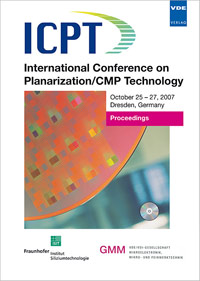Modeling for pad wear control during conditioning in CMP
Conference: ICPT 2007 - International Conference on Planarization / CMP Technology
10/25/2007 - 10/27/2007 at Dresden, Germany
Proceedings: ICPT 2007
Pages: 6Language: englishTyp: PDF
Personal VDE Members are entitled to a 10% discount on this title
Authors:
Kasai, Toshi; Anjur, Sriram; Siriwardane, Haresh; Feeney, Paul (Cabot Microelectronics Corp., 870 N. Commons Drive, Aurora, IL 60504 USA)
Abstract:
Conditioning of a pad surface using a conditioner containing embedded diamond abrasives produces loss of material (wear) from the pad during chemical mechanical planarization (CMP). Uniform pad wear is preferable, since resulting local variations in pad wear possibly affect within-wafer non-uniformity (WIWNU) in the removal rate of wafers. Pad wear attributable to the conditioning process parameters, has been previously investigated via kinematic analysis of the conditioner’s motion. The oscillatory (sweep) motion of the conditioner makes the mathematical analysis challenging and the analysis generally assumes a more random trajectory path on the pad for a given site on a conditioner. This results in determination of only an average sliding distance and limited information available about the dynamics in pad wear. The proposed analysis in the present study considers multiple measurement sites on a pad. At each site, an evaluation of the interaction time with the conditioner and the relative sliding velocity as a function of time can be conducted; thereby allowing an analysis of the time-dependent non-uniformity of the pad wear rate. An example is a localized, not random, trajectory path of a conditioner found under specific kinematic conditions. Based on the analysis, the wear rate in the radial direction is evaluated using a modified Preston’s equation and the process variables. These include geometry and motion (rotation speed, sweep range and patterns) for the conditioner. Modeling results were also compared with experimental findings and good agreement was found. This presentation demonstrates the kinematic analysis of pad/conditioner motion and discusses the verification of this technique.


